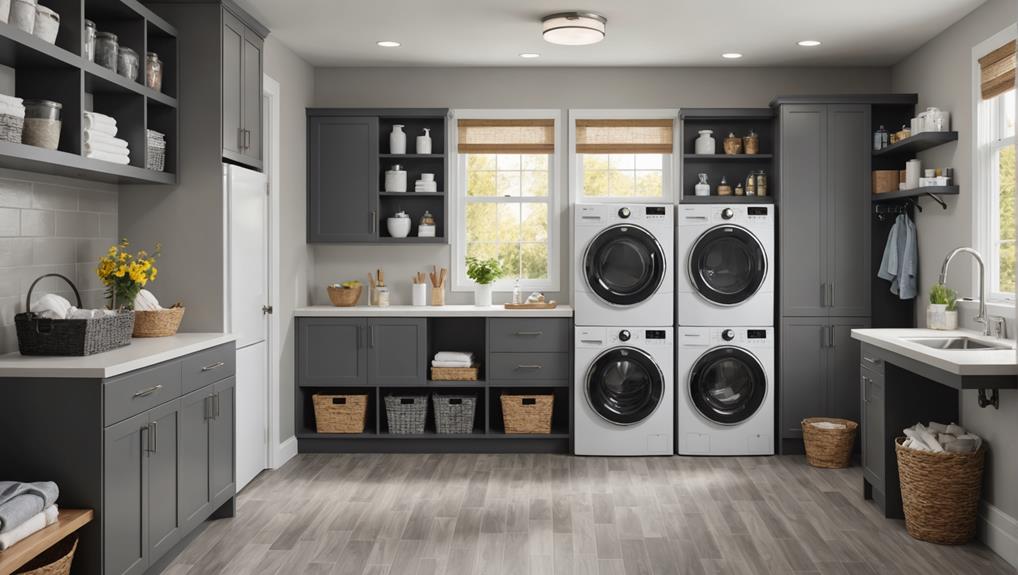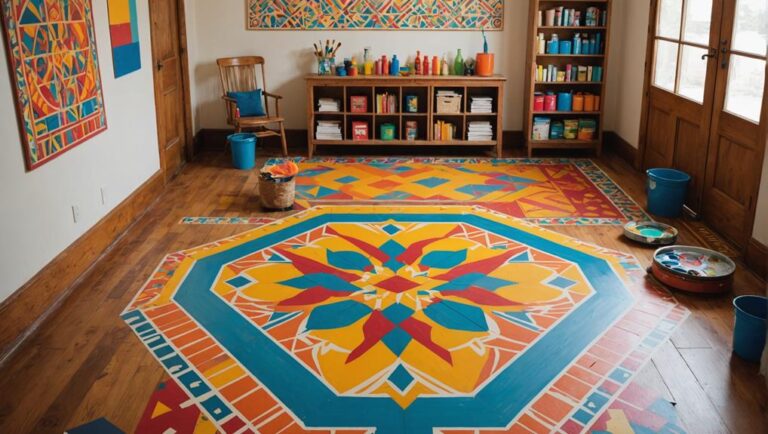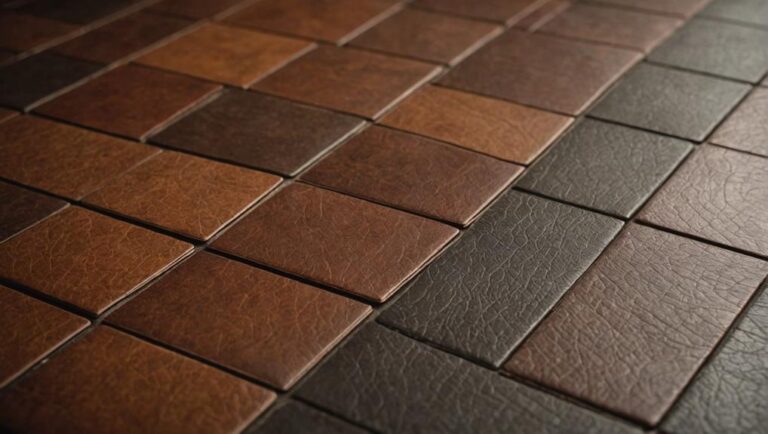For durable flooring in utility rooms, consider materials like vinyl, tile, laminate, or rubber. Vinyl is flexible, water-resistant, and cost-effective, while tile stands strong against stains and scratches, offering excellent hygiene. Laminate provides versatility with moisture barriers, making it a solid choice. If you're looking for more resilience, rubber flooring enhances comfort and safety with its slip-resistant properties. Each option requires proper installation and regular maintenance, such as sweeping and damp mopping, to maximize longevity. You'll find even more insights on making the best choice for your space.
Importance of Durable Flooring
When it comes to utility rooms, having durable flooring is essential for maintaining functionality and safety. Utility rooms often serve as high-traffic areas where heavy appliances, tools, and equipment are used. Choosing the right flooring types can greatly influence the room's usability and your overall safety.
Durable flooring options can withstand the wear and tear associated with daily use. They need to resist moisture, stains, and impacts while providing traction to prevent slips and falls. For instance, vinyl and tile are popular flooring types for utility rooms due to their water resistance and easy maintenance. These materials can endure spills from cleaning supplies or water from washing machines, ensuring that the floor remains safe and functional.
Another factor to take into account is the flooring's ability to handle heavy loads. If you're placing appliances like dryers or freezers in your utility room, you'll want flooring that can support their weight without warping or cracking. Additionally, the right flooring will facilitate easy movement of equipment and reduce the risk of accidents.
Best Materials for Utility Rooms
When choosing flooring for utility rooms, you'll want to evaluate the advantages of various materials. Vinyl flooring offers flexibility and water resistance, while tile provides exceptional durability. Additionally, concrete is known for its resilience, making it a strong contender for high-traffic areas.
Vinyl Flooring Advantages
Among the various flooring options available for utility rooms, vinyl flooring stands out due to its unique blend of durability and functionality. It's an excellent choice for high-traffic areas, as it can withstand heavy equipment and frequent use without showing wear. Vinyl flooring is also water-resistant, which is essential in utility rooms where spills and moisture are common.
When considering safety, the slip-resistant options available in vinyl flooring can help reduce the risk of accidents. It's easy to clean, minimizing the chances of dirt and bacteria buildup, which is particularly important in utility spaces.
Cost considerations play a significant role in your decision. Vinyl flooring is generally more affordable than tile or hardwood, making it a budget-friendly option. Additionally, many manufacturers are now offering eco-friendly options, allowing you to make a choice that aligns with your environmental values without sacrificing quality.
Tile Durability Benefits
While vinyl flooring offers impressive durability, tile flooring also presents significant advantages for utility rooms. One of the primary benefits of tile is its exceptional hardness and resistance to scratches, dents, and stains. This makes it an ideal choice for areas subject to heavy foot traffic and potential spills. Tile can withstand the rigors of daily use, ensuring long-lasting performance.
In addition to durability, tile aesthetics allow you to create a visually appealing space. With a variety of tile patterns and colors available, you can customize your utility room to match your style while maintaining functionality. Whether you prefer a classic look or a modern design, tile can meet your aesthetic needs without compromising safety.
Furthermore, tiles are non-porous, which means they won't absorb moisture or odors, making them easier to clean and maintain. This feature is particularly important in utility rooms, where spills and messes are common. By choosing tile for your utility room, you're investing in a flooring option that not only enhances safety and hygiene but also elevates the overall look of the space.
Concrete Resilience Features
How does concrete measure up as a flooring choice for utility rooms? When you consider durability, safety, and maintenance, concrete stands out among various concrete types. It's incredibly resilient, making it ideal for areas that endure heavy foot traffic, spills, and equipment usage. With the right surface finishes, you can enhance its functionality and aesthetic appeal.
- Slip-resistant textures: These finishes provide a safer walking surface, minimizing the risk of slips and falls.
- Stain-resistant coatings: Protect your flooring from oil, chemicals, and other spills, ensuring easy cleanup and longevity.
- Thermal mass: Concrete helps regulate temperature, keeping your utility room comfortable year-round.
When choosing the right concrete type, consider options like polished, stamped, or epoxy-coated concrete. Each offers unique benefits, from aesthetic appeal to heightened safety features. Properly installed and maintained, concrete flooring can withstand the rigors of utility room demands while providing a safe environment. By focusing on the appropriate surface finishes, you'll enhance both the longevity and safety of your flooring choice. Opt for concrete, and enjoy the peace of mind that comes from a durable, resilient surface.
Vinyl Flooring Options
When considering flooring for your utility room, vinyl offers a range of benefits, including water resistance and durability. You'll also find that installation is straightforward, making it a popular choice for DIY projects. Proper maintenance tips can help extend the life of your vinyl flooring, ensuring it remains functional and attractive.
Benefits of Vinyl Flooring
Vinyl flooring offers several advantages that make it an ideal choice for utility rooms. One of the most significant benefits is its cost effectiveness. Vinyl is often more affordable than other flooring options, allowing you to stay within budget while still achieving a durable solution. Additionally, vinyl provides a variety of designs that enhance the aesthetic appeal of utility spaces, turning a functional area into a more visually pleasing environment.
Consider these key features of vinyl flooring:
- Water resistance: Vinyl is inherently moisture-resistant, making it suitable for damp utility rooms.
- Easy maintenance: A simple sweep and occasional mopping keep your floors looking new and safe from dirt and germs.
- Comfort underfoot: Vinyl offers a softer surface, reducing fatigue when standing for extended periods during chores.
These characteristics guarantee that vinyl flooring not only meets your safety standards but also contributes to the overall functionality of your utility room. With its combination of affordability, style, and practicality, vinyl flooring stands out as a smart choice for your home.
Installation and Maintenance Tips
For a successful installation of vinyl flooring in your utility room, proper preparation is essential. Begin by confirming the subfloor is clean, dry, and level. Inspect for any damages or irregularities; these must be addressed to avoid future issues. Familiarize yourself with the latest flooring trends to choose a style that complements your space while meeting functional needs.
When it comes to installation techniques, consider using the floating method, which allows the vinyl planks to expand and contract freely. This reduces the risk of buckling over time. If you opt for glue-down vinyl, apply adhesive evenly and follow manufacturer guidelines for curing times to confirm a secure bond.
Regular maintenance is key for longevity. Sweep or vacuum the floor weekly to remove debris that could scratch the surface. For deeper cleaning, use a damp mop with a gentle vinyl floor cleaner. Avoid harsh chemicals, as they can deteriorate the material. By following these installation and maintenance tips, you'll not only enhance the durability of your vinyl flooring but also create a safe, functional utility room environment.
Tile Flooring Benefits
Why should you consider tile flooring for your utility room? Tile flooring offers numerous benefits that make it an ideal choice for spaces prone to spills, moisture, and heavy foot traffic. With tile aesthetics that can enhance the overall look of your utility room, you won't have to sacrifice style for functionality.
Here are some key advantages of tile flooring:
- Water Resistance: Tiles are impervious to water, making them perfect for utility areas where spills are common.
- Durability: Tile is known for its strength and can withstand heavy loads and wear, ensuring longevity.
- Easy to Clean: A simple wipe-down with a damp cloth or mop is often all it takes to keep your tiles looking pristine.
When considering tile installation, it is essential to recognize that proper installation is vital for maximizing these benefits. An expertly installed tile floor will minimize gaps, reducing the risk of moisture infiltration and enhancing the floor's stability. Additionally, tiles come in various styles, allowing you to select a design that fits your personal taste while maintaining safety standards.
Laminate Flooring Features
While tile flooring offers impressive durability and water resistance, laminate flooring presents its own set of compelling features that make it a strong contender for utility rooms. One of the standout aspects of laminate is its versatility in design. With a variety of laminate textures and colors, you can easily find an option that complements your utility room's aesthetics while maintaining functionality.
Laminate flooring is engineered to withstand the rigors of heavy foot traffic and occasional spills, making it a practical choice for utility spaces. The surface is designed to be both scratch-resistant and easy to clean, ensuring you can maintain a safe and sanitary environment.
Here's a quick comparison of laminate flooring features:
| Feature | Description | Benefits |
|---|---|---|
| Laminate Textures | Available in wood, stone, and more | Enhances aesthetic appeal |
| Laminate Colors | Wide range of colors to choose from | Customizable to your décor |
| Water Resistance | Most laminate options have moisture barriers | Protects against spills |
| Easy Installation | Click-lock systems for simple setup | Saves time and reduces costs |
Rubber Flooring Advantages
When considering flooring options for utility rooms, rubber flooring stands out due to its unique combination of durability and slip resistance. This makes it an ideal choice for spaces that often deal with spills, heavy foot traffic, and various activities. One of the primary advantages of rubber flooring is its impressive slip resistance, which greatly reduces the risk of accidents in potentially hazardous environments.
Here are some key benefits of rubber flooring:
- Sound Absorption: The dense material naturally dampens noise, creating a quieter work environment.
- Thermal Insulation: Rubber flooring provides a comfortable surface underfoot, even in cooler spaces, enhancing overall comfort.
- Eco-Friendly Options: Many rubber flooring products are made from recycled materials, offering a sustainable choice for environmentally conscious consumers.
Additionally, rubber flooring is incredibly versatile in design. You can find it in a range of colors and patterns, allowing you to customize the look of your utility room while maintaining functionality. Its durability means it can withstand heavy use, resisting wear and tear over time.
Furthermore, you'll appreciate the ease of maintenance rubber flooring offers. A simple cleaning routine can keep it looking pristine, making it a practical choice for busy utility spaces. To sum up, rubber flooring combines safety features, comfort, and design versatility, making it an excellent option for your utility room needs.
Installation Considerations
Before you start installing rubber flooring in your utility room, it's vital to evaluate several factors that can impact the overall success of the project. First, consider the cost factors involved. Rubber flooring can vary greatly in price based on quality, thickness, and style. Budgeting correctly will help you avoid overspending and guarantee you select a product that meets your needs without compromising safety or durability.
Next, assess the design options available. Rubber flooring comes in various colors and patterns, allowing you to create a functional and visually appealing space. Think about how these design choices can enhance safety; for instance, choosing a textured surface can reduce the risk of slips and falls, which is especially important in utility areas prone to moisture.
You'll also want to examine the subfloor condition before installation. A clean, dry, and level surface is essential to guarantee proper adhesion and longevity of the flooring. If your subfloor has imperfections or moisture issues, address them before proceeding.
Maintenance Tips for Longevity
To guarantee the longevity of rubber flooring in your utility room, regular maintenance is essential. Proper care will not only enhance the appearance of your flooring but also make certain it remains safe and functional for years to come. Here are some key maintenance tips to help you achieve this:
- Routine Cleaning: Sweep or vacuum the floor regularly to remove dirt and debris that can cause scratches.
- Mopping: Use a damp mop with a mild detergent to clean up spills. Avoid harsh chemicals that could damage the rubber surface.
- Flooring Inspections: Regularly inspect your flooring for signs of wear or damage. Early detection can prevent more significant issues down the line.
Incorporating effective cleaning techniques is crucial. Always use a pH-neutral cleaner specifically designed for rubber flooring to avoid deterioration of the material. Make sure to follow the manufacturer's recommendations for cleaning products and methods. After mopping, dry the floor thoroughly to prevent slips and maintain traction.
Additionally, keeping an eye on the edges and seams of your flooring will help you catch any potential problems early. If you notice any lifting or separation, address it immediately to avoid further damage.
Frequently Asked Questions
How Do I Choose the Right Color for Utility Room Flooring?
Choosing the right color for flooring can feel like a monumental decision, akin to selecting the perfect hue for a masterful painting. You'll want to contemplate color psychology; warm tones can create a welcoming atmosphere, while cooler shades promote calm. Stay updated with flooring trends to guarantee your choice remains stylish. Additionally, think about safety—darker colors can hide stains better, while lighter ones may create a brighter, more spacious feel.
Can I Install Durable Flooring Over Existing Floors?
Yes, you can install durable flooring over existing floors, but be aware of potential installation challenges. First, check the condition of the existing surface; it should be clean, dry, and level. Certain flooring materials, like vinyl or laminate, can often be installed directly on top. However, make certain that the additional height doesn't interfere with door clearances or changes. Always prioritize safety and follow the manufacturer's guidelines for best results.
What Is the Average Cost of Durable Flooring for Utility Rooms?
Oh, the joys of flooring shopping! When it comes to the average cost of durable flooring, you're looking at a range of $2 to $10 per square foot, depending on the flooring materials you choose. A thorough cost comparison reveals that vinyl and laminate often win for budget-conscious consumers, while tile and hardwood might appeal to those seeking elegance. Just remember, investing wisely guarantees safety and durability for your space.
Are There Eco-Friendly Options for Utility Room Flooring?
Yes, there are eco-friendly options for flooring that prioritize sustainability. You might consider materials like bamboo, cork, or reclaimed wood, which are all sustainable and can withstand wear. For maintenance, keep them clean with a damp mop and avoid harsh chemicals to guarantee safety. Regularly inspect for damage to prolong their life. By choosing sustainable materials, you're not only protecting the environment but also creating a healthier space for you and your family.
How Long Does Durable Flooring Typically Last in Utility Rooms?
Durable flooring typically lasts anywhere from 10 to 30 years, depending on the material and maintenance. For ideal longevity, you're encouraged to follow maintenance tips like regular cleaning and addressing spills promptly. Additionally, check your flooring warranties, as they often provide insight into expected lifespan and coverage for defects. By ensuring proper care, you can enhance safety in your space and prolong the life of your flooring investment, keeping it functional and visually appealing.




